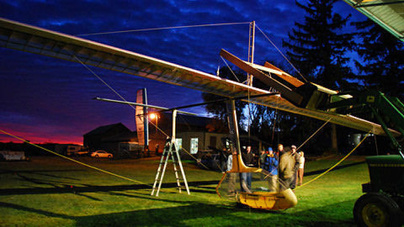Human-powered 'flapping-wing' plane first ever to take flight (video)

Over half a millennium ago, Leonardo da Vinci sketched the first human-powered ornithopter. For centuries since, engineers have attempted to build a human-powered aircraft with flapping wings. Now, a University of Toronto PhD candidate made aviation history with the first ornithopter of its kind to fly continuously.
Todd Reichert has achieved what's believed to be an aviation first. He built a human-powered aircraft, "Snowbird," with flapping wings which he hopes has set a world record. Under his power and control, the wing-flapping device sustained both altitude and airspeed for 19.3 seconds, and covered a distance of over 475 feet at an average speed of 15.9 miles per hour.
Built from carbon fiber, foam, and balsa wood, the Snowbird weighs just 94 lbs. and has a wingspan of 105 feet, which is comparable to that of a Boeing 737--amazingly, the Snowbird weighs less than all of the pillows on board.
The record-breaking flight occurred on August 2 at the Great Lakes Gliding Club in Tottenham, Ont., and was witnessed by the vice-president of the Fédération Aéronautique Internationale (FAI), the world-governing body for air sports and aeronautical world records. According to a university release, the official record claim was filed this month, and the FAI is expected to confirm the ornithopter's world record at its meeting in October.
An article covering the project back in 2004 explains how a human-powered ornithopter works:
The full-scale ornithopter is an engine powered aircraft that carries one pilot. All of the thrust and nearly all of the lift is created by the mechanical flapping of the ornithopter's wings. The two wings of the craft are joined by a centre section which is moved up and down by pylons connected to the drivetrain. The wings' thrust is due primarily to a low-pressure region around the leading edge, which integrates to provide a force known as "leading-edge suction". The wings also passively twist in response to the flapping. This is due to a structure that is torsionally compliant in just the right amount to allow efficient thrusting ("aeroelastic tailoring"). It should be noted, though, that twisting is required only to prevent flow separation on sections along the wing. It does not produce thrust in the same way as required by sharp-edged wings with little leading-edge suction.
The accomplishment took more than Reichert's will and dedication. The Snowbird development team also included a couple of University of Toronto students, community volunteers, and UTIAS Professor Emeritus James D. DeLaurier, who laid much of the foundation for a full-scale piloted omithopter.
"Throughout history, countless men and women have dreamt of flying like a bird under their own power, and hundreds, if not thousands have attempted to achieve it. This represents one of the last of the aviation firsts," said Reichert.
HPO The Snowbird from U of T Engineering on Vimeo.
